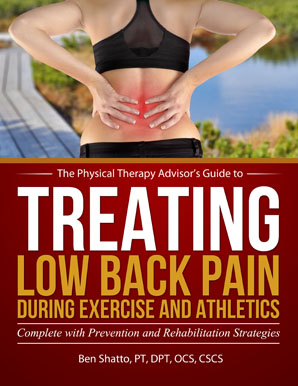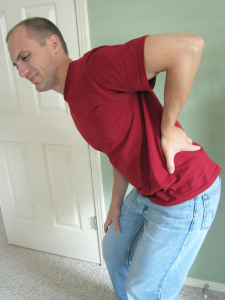You caught me red-handed! A physical therapist with a lapse in judgment which lead to an injury that I could have avoided had I followed my own advice. During an early morning workout, I recently tweaked my low back. I’m guilty of being exhausted, using poor technique, and not taking a rest day. Sound familiar?
In the following days (as I was forced to rest although I would rather have been at the gym), I drafted a rather cheeky list of risk factors and how to maintain a healthy back.
12 Sure Fire Ways to Injure Your Back:
- Start Smoking – Smoking is a major risk factor for low back pain (LBP). The chemicals in cigarette smoke affect both the lunges’ ability to exchange oxygen and the body’s normal healing response. These chemicals alter the blood supply to the discs and other spinal structures which affects nutrient exchange and increases the risk of pain. Healing time for all medical conditions worsen with smoking.
- Be Male – Males have a higher risk of LBP. Females tend to experience more cervical or neck pain. (Obviously, you have very little control over this factor other than the knowledge that you’re at an increased risk if you are a male.)
- Choose Parents Who have Experienced LBP – A family history of low back pain increases your risk. In some cases, this may be due to actual structural deformities which may be genetically linked. More commonly, it’s a learned behavior, such as chronic sitting and slouching (poor posture), that can lead to a higher risk of LBP.
- Prior Episodes of LBP – Once you have experienced LBP, you are more likely to have re-current episodes. This is partially due to weakness in the deep multifidus muscles that help support the spine and prevent shearing forces. This weakness can be addressed with proper physical therapy intervention.
- Have a Baby – Pregnancy increases your risk for LBP due to structural changes as the baby develops and hormones change. The expectant mother releases relaxin, a hormone which loosens the whole body, to prepare for the baby’s delivery. Again, a risk worth taking! Most women can manage the pain by modifying posture and movements while learning techniques for self-management.
- Don’t Exercise – A sedentary lifestyle will increase your risk for LBP. The spine is designed to work and move. In order for the spine to remain healthy, it requires exercise and movement.
- Sit for more than 2 Hours a Day – Sitting for a long period of time not only affects your general health status in a negative way, but it also increases your risk for LBP. To increase your risk further, be a heavy equipment operator who sits on a vibrating surface! Please refer to The #1 Way to Extend Your Life Span for the reasons why sitting has such a negative effect on your body.
- Practice Poor Posture – In western culture, we spend most of our day sitting slouched or standing hunched over. This is an excellent way to increase your risk for LBP. It’s one of the major risk factors for disc herniation and development of spinal stenosis. Please refer to How to Improve Posture & Eliminate Pain for exercises that can help you to develop better posture and strength to eliminate back pain.
- Don’t Warm Up Before Exercise – This is a common mistake which can lead to injury. Jump out of your bed in the morning without warming up, and then start your exercise routine. (Please don’t!) Instead, prepare your body for challenging activities in order to avoid injury. A warm up should consist of a cardiovascular component and a dynamic stretching routine of the actual exercises you will be performing to insure you’re ready for the movement. This is also pertinent for weightlifting and running.
- Keep Moving even when Exhausted – This is a common problem among CrossFitters (including myself). Just keep pushing yourself even when you can’t see straight. Typically, this results in poor technique which further increases your risk. Combine poor technique with muscles which can no longer perform the proper movement pattern, and you are likely to become injured. High Intensity Training (HIT) is a wonderful form of exercise and has many health benefits as long as you’re able to properly perform the exercise.
- Use Poor Technique – Poor technique, along with feeling exhausted, often occurs when performing exercises that are too advanced. Performing unfamiliar lifting techniques or lifting too much weight will likely result in poor technique. Please see your coach, athletic trainer, or physical therapist for the proper technique for your activity of choice.
- Keep the Training Volume High – Who needs a rest day? All of us can benefit from taking a break. Training every day without regard to rest is an excellent way to cause over training syndrome and injury.
Low back pain is a serious and debilitating condition. It will either most certainly affect you or someone close to you. Be mindful of your risk factors and be pro-active in maintaining a healthy back! Don’t let LBP affect your ability to stay active and keep enjoying your favorite activities!

AVAILABLE NOW ON AMAZON!
In my book, Treating Low Back Pain during Exercise and Athletics, you will learn how to address specific causes of LBP as well as the best practices on how to prevent and self-treat when you experience an episode of LBP. In this step-by-step LBP rehabilitation guide (complete with photos and detailed exercise descriptions), you will discover how to implement prevention and rehabilitation strategies to eliminate pain and get back to training and exercise sooner.
Learn how to prevent, self-treat, and manage LBP so you can get back to your daily life and exercise goals more quickly without additional unnecessary and costly medical bills!

